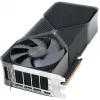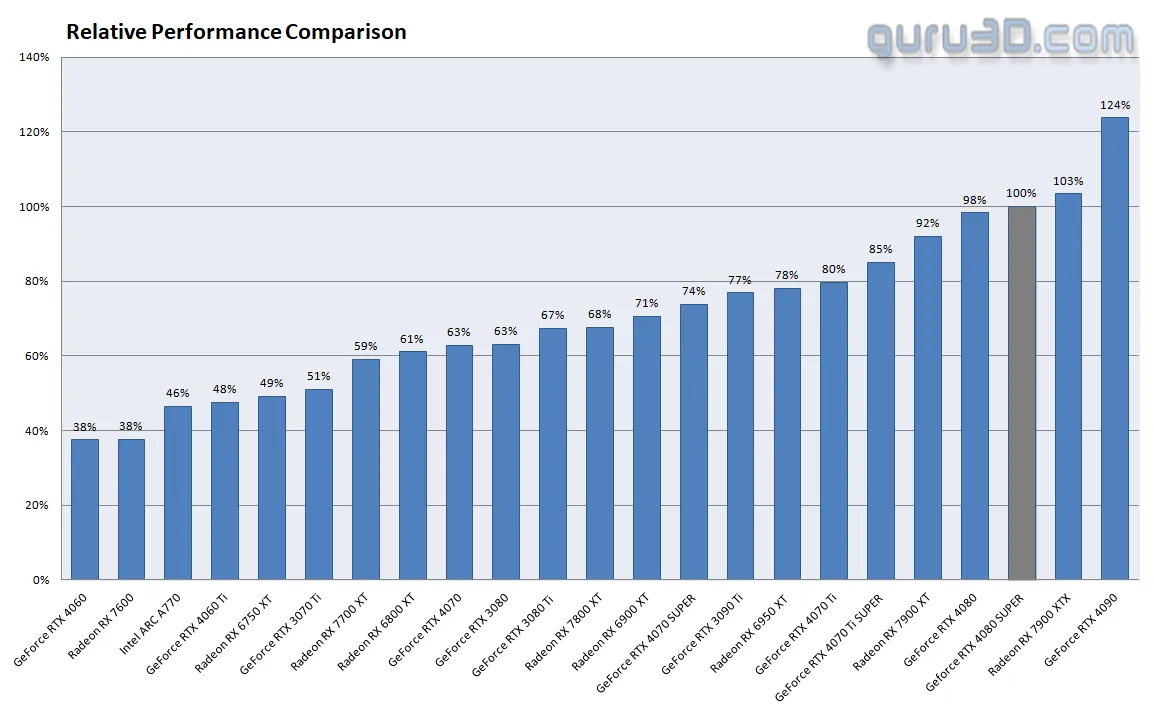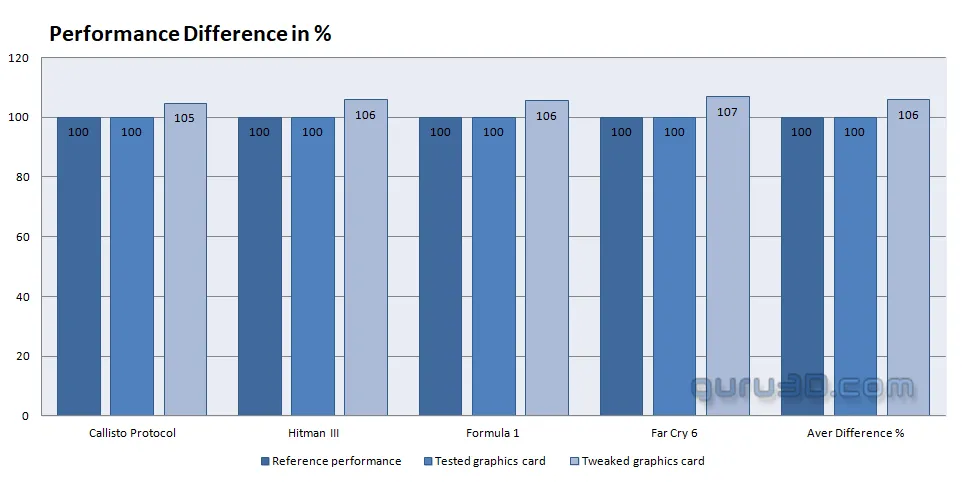Final words and conclusion
There you have it, the GeForce RTX 4080 SUPER, in particular the founder edition from NVIDIA themselves. Yes, it reveals only a small diminutive advancement in graphics performance, despite more sahders and faster memory, mainly due the same TGP of 320W. The biggest change however is a very positive one, pricing. The original GeForce RTX 4080 was priced $1199, and here we have the spiced-up refresh model that runs a bit faster with an MSRP of $999. We can appreciate that, it also makes the 'older' 4080 abundant, and as such NVIDIA will phase out its sales to be replaced with this SUPER model. Much like the entire 4000 series, the GeForce RTX 4080 also focuses heavily on Deep Learning Super Sampling (DLSS) technology, with upgraded Tensor cores supporting DLSS 3.5. This enhancement is reported to double performance efficiency, and NVIDIA suggests potential future gains of three to four times with optimized game implementations. From a visual perspective, the graphics rendered on monitors are impressive, offering a high-quality visual experience. Another aspect of debate remains the 12VPWR power connector introduced with these cards. While the connector itself is deemed safe, issues (can) arise when bending the cables too near the connector, especially if the cables are of lower quality. This can create potentially hazardous situations. Our recommendation is to bend cables at least 3-4cm away from the connector, ensuring they are securely and tightly plugged in. Our tests, including FLIR imaging assessments, have not revealed any safety issues with the connectors on these cards. And we tested a lot of them by now.
Geforce RTX 4080 SUPER:
- CUDA Cores: 10240
- Memory: 16GB GDDR6X at 23 Gbps
- Total Graphics Power (TGP): 320W
- Power Consumption: Approx. 246W during gameplay, 15W in idle
- Key Features: 4K Full RT gaming, advanced AI capabilities
- Expected Release Date: January 31
Performance
The performance metrics are clear, the GeForce RTX 4080 series (yes both 4080 and 4080 SUPER) stands out, particularly in gaming performance and rendering quality. This card offers better value compared to the 4090, achieving high-level performance that facilitates 4K resolution gaming. It's ideal for enthusiast gamers who use Ultra-Wide HD (UWHD), Quad HD (QHD), or Ultra HD (UHD) monitors. The RTX 4080 features an advanced rasterizer engine that surpasses previous performance limits, thanks in part to its 10k Shading processors. Additionally, the RTX 40 series introduced a new generation of Ray tracing and Tensor cores, which have proven to be significantly more powerful. The core counts of RT and Tensor should not be the sole focus; their performance efficiency is what truly matters. Located near the shader engine, these cores have become more efficient, a fact that is evident in their output. While Tensor cores are often challenging to quantify, our observations indicate robust performance, as evidenced by the impressive results with DLSS3 technology. The GeForce RTX 4080 is versatile, delivering super performance (pardon the pun) at resolutions ranging from 2K (2560x1440) to 4K (3840x2160).
Cooling & noise levels
The cooling design of the GeForce RTX 4080 SUPER FE is notably efficient. As a high-end gaming product, it naturally consumes a considerable amount of power. On average, the founder edition of the card uses about 275-320 Watts under full load. This power usage directly correlates to the amount of heat generated by the GPU inside a closed case. In terms of acoustics, the card reaches around 37 to 38 dBA under intense stress, which is a gradual process as the card slowly heats up. This noise level is within the typical range for such devices. Under stress, the GPU temperature can reach approximately 65 to 70°C, with variations depending on the airflow within the computer chassis. Thermal imaging tests reveal no alarming issues. However, it's important to note that custom versions of the card from different manufacturers may exhibit higher power consumption due to factors like increased Total Graphics Power (TGP), RGB lighting, and liquid cooling systems.
Energy consumption
We previously mentioned the power consumption of the GeForce RTX 4080, which is notably high, especially in the context of rising energy prices. Our measurements indicate that the power draw under intense gaming conditions is around 300-325 Watts. This increased power consumption is the compromise for enhanced performance in this specific model of the graphics card. In typical gaming scenarios, the power usage can vary but often exceeds 275-300 Watts. It is anticipated that cards from board partners may exhibit even higher power consumption due to increased Total Graphics Power (TGP) allowances.
Coil whine
The presence of coil squeal in any GeForce RTX 4080 graphics card can vary, depending on the degree of the issue. It becomes audible when reaching high framerates, but typically remains at a manageable level. Within an enclosed case, this sound is likely to blend into the background noise. In our experience with this specific card, the coil squeal has been hardly noticeable but we did hear it on occasion.
Pricing
The suggested retail price for the NVIDIA GeForce RTX 4080 SUPER, as set by the manufacturer, is $999 for the MSRP products. This price point is relatively high but far better than the original $1199, especially when considering that the ideal cost for a graphics card should be lower than that of a current gaming console. Add-in Board (AIB) versions, which offer more advanced products (relatively speaking), will likely get priced higher. It is expected that these models will cost an extra $50-100. Now, I can say all kinds of rude things about prices, but these products will still sell no matter what I say.
Tweaking
The graphics card demonstrates effective tweaking capabilities. When the power limiter is set to +10%, the GPU consistently reaches its power limit, indicating this is a primary and efficient adjustment method. This adjustment allows for improved performance within the card's default power allocation. Additionally, the clock frequency can be safely increased by approximately +200 MHz, resulting in the GPU's boost clock reaching between 2900 MHz. Of course, these frequencies can vary depending on the specific game title, as they dynamically adjust. The card's memory also shows potential for enhancement, capable of reaching up to 23.5 Gbps. These combined adjustments have yielded an approximate 6% increase in performance, especially in demanding GPU scenarios, compared to the baseline performance of the founder edition reference model.
Conclusion
Here's the reality for the GeForce RTX 4080 SUPER, its hardware and performance are commendable but the performance differential towards the existing RTX 4080 is often within a 1-2% baseline, e.g. close to nothing. While it has more shaders and faster memory, both cards are tied towards the very same 320W TGP mainly resulting in that close to NIL performance differential. The biggest benefit of the series thus is pricing. The ADA GPU architecture of the 4080 SUPER demonstrates proficient performance. It boasts about 1.5 times the raw shader performance compared to its predecessors, along with enhanced Raytracing and Tensor core capabilities. Technologies like Shader Execution Reordering (SER) and DLSS 3 further enhance the capabilities of the Series 4000, making it a standout product. Add to that features like DLSS 3.5 with ray Reconstruction and Frame generation and you are bound to be able to use this graphics card for years. The GeForce RTX 4080 is notable for its impressive performance numbers. It is particularly suitable for gamers who use Ultra HD or have a minimum monitor resolution of 2560x1440. For those who can afford it, the 4080 SUPER is a valuable addition to any high-end gaming setup. For instance, games like Microsoft Flight Simulator 2020, when combined with DLSS 3.0, achieve over 100 FPS at high resolutions. Similarly, Cyberpunk in UHD, raytracing, and DLSS 3.5, exceeds 100 FPS. The recent move towards Ray reconstruction also moved NVIDA into that sweet spot. The card excels in Ultra HD gaming, whether using standard shading or a combination of hybrid ray-tracing and DLSS 3.0/3.5. The 4080 SUPER at $999 is now more affordable than the 4080, it still represents a significant financial commitment, offering a very nice performance.
- Download NVIDIA GeForce drivers
- Sign up to receive a notification when we publish a new article.
- Or go back to Guru3D's front page
- Hilbert, LOAD"*",8,1.



